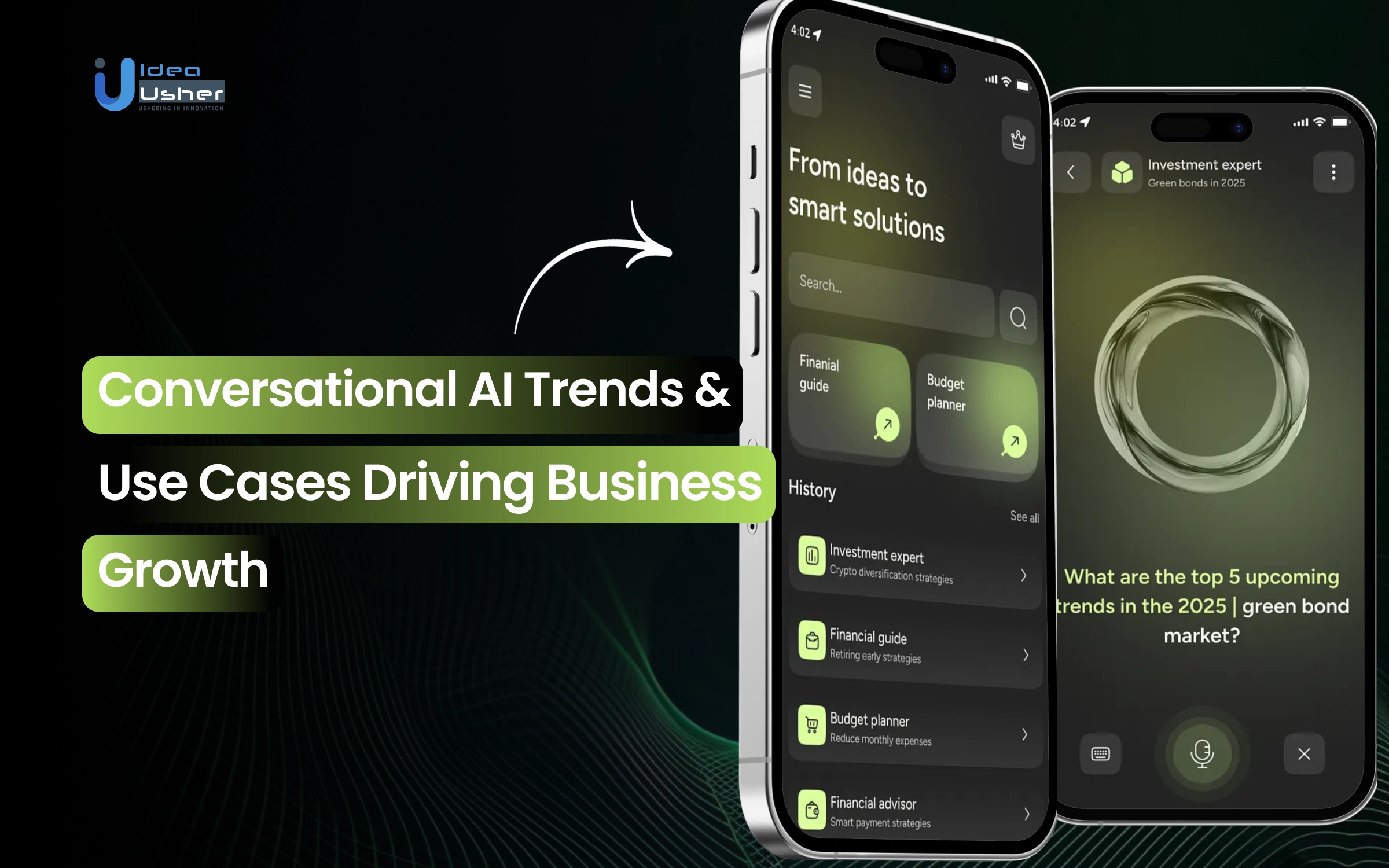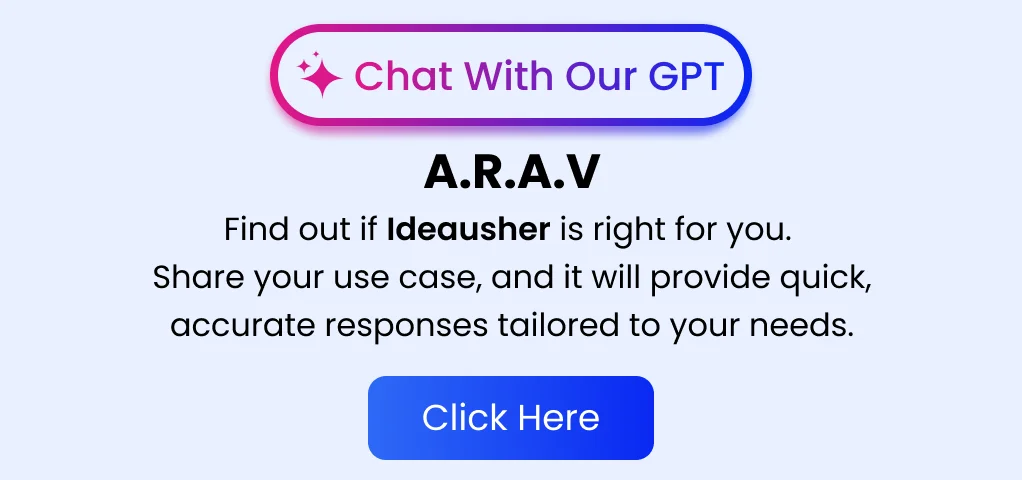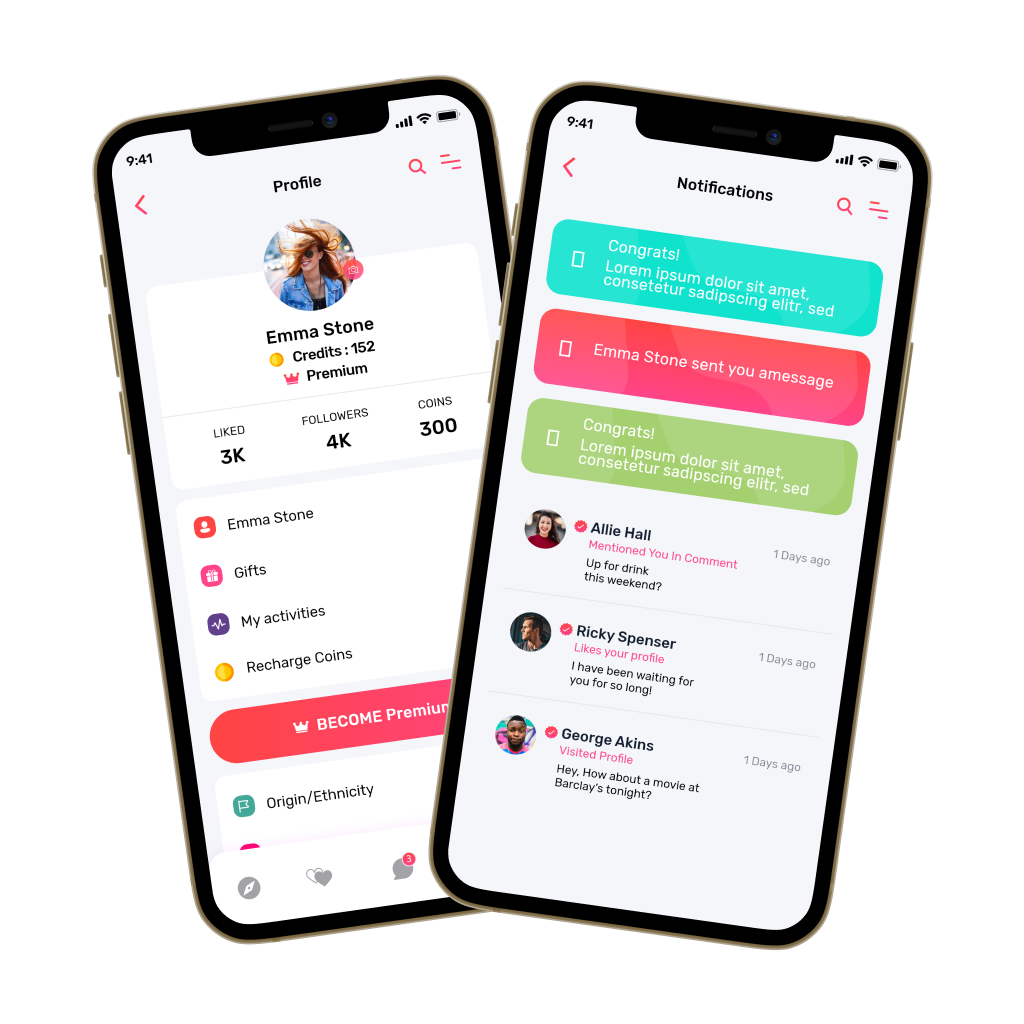The way customers interact with businesses is changing as they want quick, personalized and instant communication. That’s why businesses can no longer rely on static FAQs or delayed human responses to keep people engaged. Conversational AI helps meet these expectations by giving instant answers, personalized recommendations and 24/7 availability, making every conversation feel natural and building trust with each interaction.
Conversation AI chatbots can now understand what people mean, and virtual agents can have conversations that feel real. This technology has grown past simple, scripted answers. Today, it helps businesses offer better support, tailor customer experiences, and boost sales, all by using natural, data-driven conversations.
In this blog, we’ll explore the key Conversational AI trends shaping today’s market, the most impactful use cases across industries, and how forward-thinking companies are using these innovations to fuel growth and stronger customer connections. With proven expertise in building AI solutions, IdeaUsher helps businesses turn these trends into practical products that enhance engagement and drive better results.

What is Conversational AI?
Conversational AI refers to artificial intelligence technologies that enable computers to simulate human-like conversations through voice or text. It powers chatbots, virtual assistants, and customer support tools that understand, process, and respond to user inputs in a natural, contextual manner.
By combining natural language processing (NLP), machine learning (ML), and speech recognition, conversational AI allows systems to interpret user intent, hold meaningful dialogues, and continuously improve through feedback. This leads to more natural, personalized, and human-like experiences. Some key capabilities include:
- Natural language understanding (NLU): Accurately interprets user inputs, intent, and context
- Human-like response generation: Produces relevant and coherent answers in real time
- Context-aware conversations: Remembers previous interactions to maintain meaningful dialogue
- Multichannel communication: Works across voice, chat, messaging apps, and websites
- Continuous learning and improvement: Enhances responses based on past interactions and feedback
- Personalization at scale: Tailors experiences based on user data and behavior
- Automation of routine tasks: Handles repetitive processes, improving efficiency and reducing workload
- Integration with business systems: Connects to CRMs, help desks, and other tools for seamless operations
How Conversational AI Works in Business?
Conversational AI helps businesses automate communication, understand what customers want, and provide helpful, human-like responses on different platforms. Here’s a step-by-step look at how it works behind the scenes:
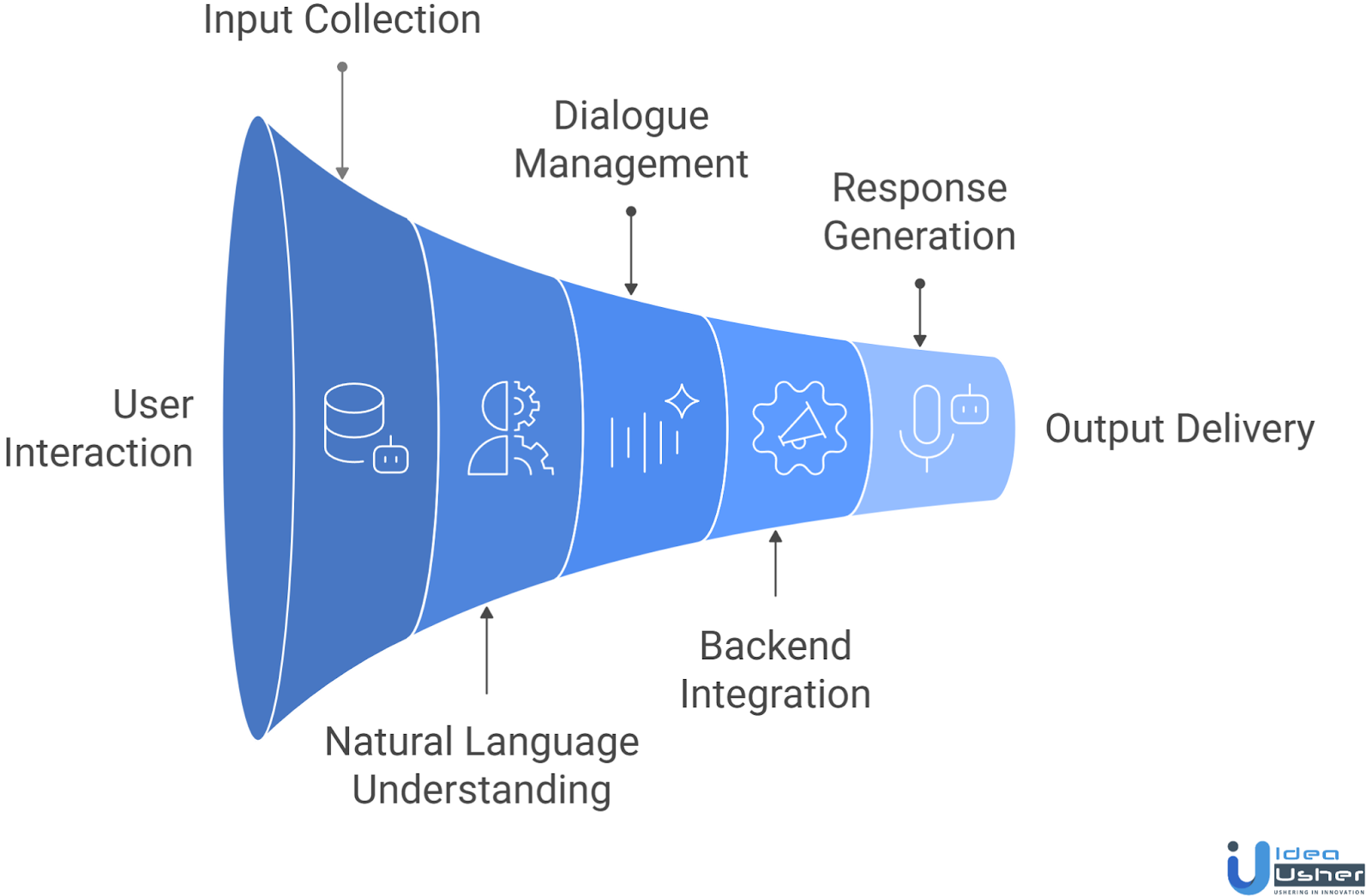
1. Input Collection
The process starts when someone interacts with the system by typing or speaking, like when using a chatbot or voice assistant. Collecting this input accurately is important for the AI to understand and respond well.
2. Natural Language Understanding
Once input is collected, AI uses Natural Language Understanding (NLU) to interpret user intent, identify key details, and analyze questions. Techniques like sentence breakdowns and mood assessment improve accuracy.
3. Dialogue Management
After the AI understands what the user wants, Dialogue Management figures out the best way to reply. It looks at the conversation so far, follows business rules, and uses context to keep the conversation natural and clear, even if it goes back and forth several times.
4. Backend Integration & Data Retrieval
To give the right information, the AI connects to business tools like CRMs, ERPs, or APIs. For instance, it can check an order’s status instantly, which helps automate tasks and makes operations run more smoothly.
5. Response Generation
Once the AI has the needed information, it uses Natural Language Generation (NLG) to create a reply. This could be a quick message, a suggestion, or a voice response, always aiming to sound natural and match the company’s style.
6. Output Delivery
The AI then sends the reply through the channel the user prefers, like website chat, WhatsApp, email, or a phone call. This helps keep communication smooth and consistent across all platforms.
Latest Conversational AI Trends Shaping the Market
Conversational AI is evolving from simple chatbots to improving business engagement, automation, and personalized communication. With dynamic responses and AI copilots boosting productivity, it’s gaining new intelligence and adaptability. Below are the latest Conversational AI Trends & Use Cases.
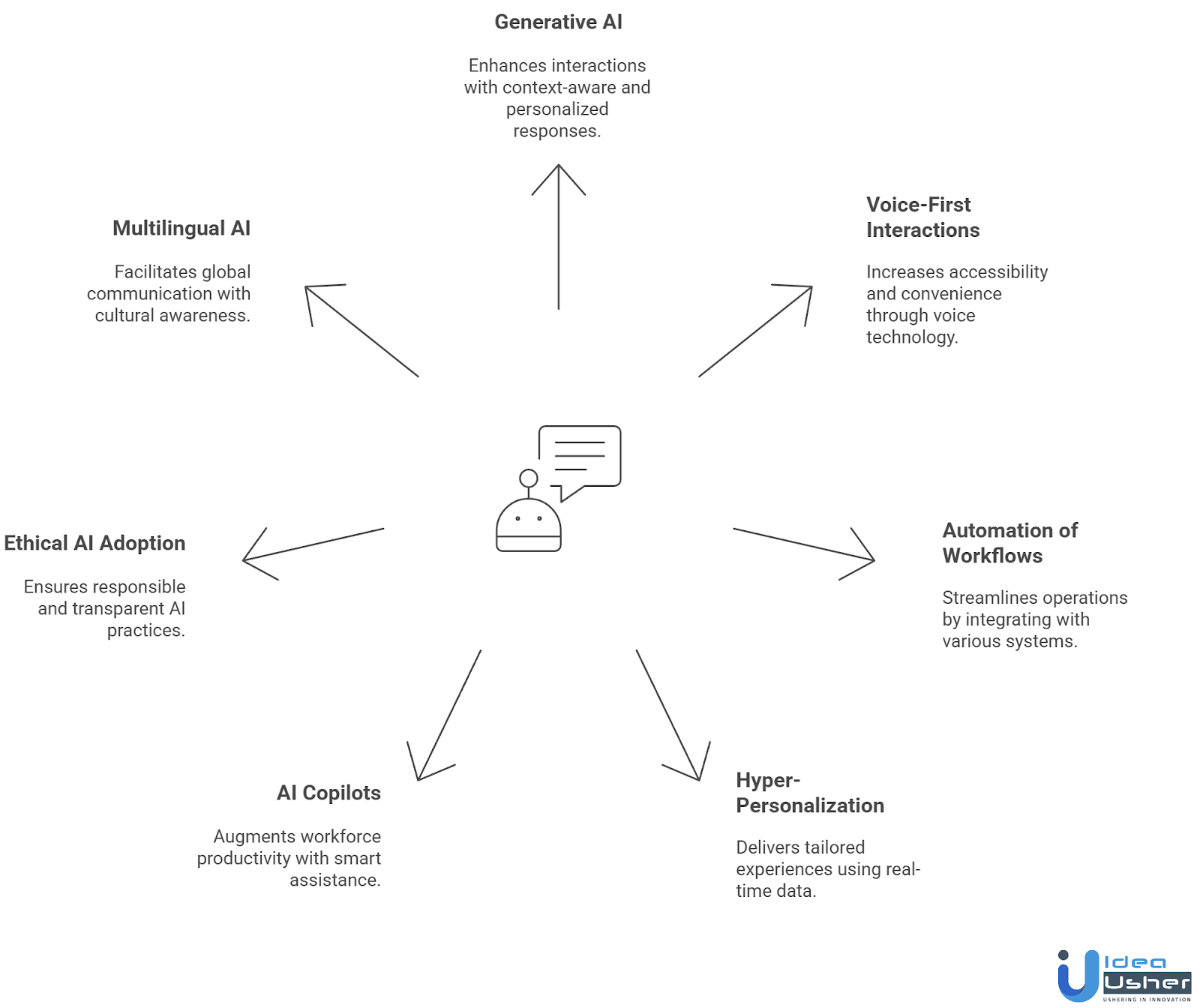
1. Generative AI for Dynamic Responses
Generative AI models like GPT-5 and Claude 3 deliver context-aware, adaptive, and emotionally intelligent replies that mimic human understanding. This enables more natural, personalized interactions that boost engagement. Businesses use these models to manage complex queries and real-time support.
2. Voice-First Interactions Growing Rapidly
Voice AI adoption is rising across industries with smart speakers, in-car assistants, and voice support. NLP and speech recognition advances make interactions more reliable. Companies improve hands-free, multilingual experiences in banking, retail, and healthcare.
3. Automation of Complex Workflows
Conversational AI manages workflows across platforms by integrating with CRMs, ERPs, and ticketing systems. It automates tasks from lead qualification to order processing, reducing manual work and ensuring data consistency. For enterprises, this means smarter workflows and scalable costs.
4. Hyper-Personalization Using Real-Time Data
Modern conversational AI uses behavioral analytics and real-time data to deliver hyper-personalized interactions, analyzing user intent, purchase history, and emotional tone for relevant suggestions. This transforms engagement into a data-driven experience, boosting conversions and loyalty.
5. AI Copilots for Workforce Augmentation
AI copilots are essential smart assistants in enterprises. They provide insights, automate tasks, and access knowledge. They speed up decisions, reduce repetitive work, and boost productivity in sales, healthcare, and even HR. Unlike traditional automation, AI copilots adapt in real time to workflows and intent.
6. AI Governance & Ethical AI Adoption
As conversational AI advances, governance and ethics are crucial. Companies prioritize transparency, bias reduction, and data protection to build trust and comply with regulations. Ethical guidelines promote fair training, while governance ensures transparency and security, especially in finance and healthcare.
7. Multilingual AI for Global Expansion
Digital adoption drives conversational AI with multilingual, culturally aware interactions. Translation AI understands dialects and context for seamless global communication. This helps brands scale while maintaining authentic, personalized experiences and supporting inclusive global strategies.

The Reason Behind Conversational AI Growth
The global conversational AI market was estimated at USD 11.58 billion in 2024 and is projected to reach USD 41.39 billion by 2030, growing at a CAGR of 23.7% from 2025 to 2030. This growth reflects increasing use of AI chatbots and virtual assistants across industries to improve customer engagement and automate communication.
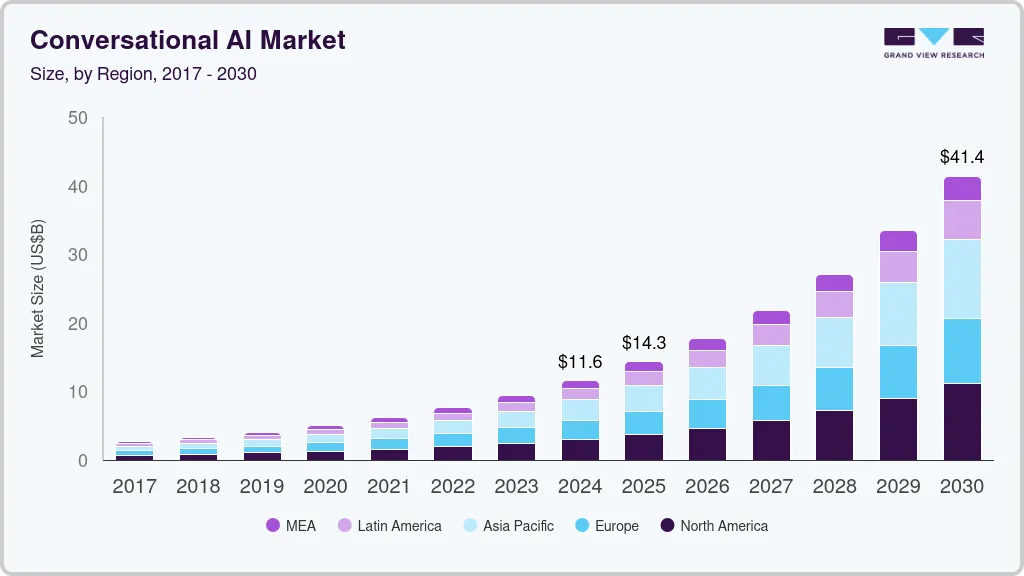
A clear sign of market momentum is the substantial venture capital and private-equity funding pouring into conversational AI platforms. Below are some examples:
- Decagon AI raised US$131 million in a Series C funding round in June 2025, with a valuation reported at about US$1.5 billion. Their focus: enterprise conversational AI agents across chat, email, voice and SMS channels.
- Synthflow AI closed a US$20 million Series A investment round in June 2025 for its no-code voice-AI platform that automates customer calls and BPO workflows.
- Maki raised £23.4 million (~ US$28.6 million) in early 2025 (Series A) to build conversational-AI agents for talent-acquisition workflows.
- Yellow.ai has raised over US$102 million to date (including US$78.15 million in Series C) to scale its conversational AI platform supporting 135+ languages and 35+ channels.
Why this rapid growth?
Several key drivers are fuelling this expansion:
- Rising demand for better customer experience: Companies are replacing static FAQ bots with dynamic conversational agents that offer instant, human-like responses across channels.
- Advances in AI and language technology: Better NLP, LLMs, and speech technology make conversational agents more capable, accurate, and easier to deploy.
- Lower operational costs and better scalability: Conversational AI automates customer service, reduces agent workload, handles 24×7 demand, and scales globally, offering strong ROI.
- Omni-channel adoption and digital transformation: As companies digitize, conversational AI becomes a key interface across websites, apps, voice, IoT, and messaging platforms.
- Global reach and multilingual support: Many platforms support multiple languages, helping enterprises deploy globally and grow in new markets.
- Rise of industry-specific solutions: Conversational AI is tailored for industries like finance, healthcare, retail, and travel, accelerating adoption and market growth.
How Conversational AI Helped Businesses Boost Sales by 67%?
The chatbot icon may be everywhere, but real-world usage remains somewhat selective: 62% of users interact with chatbots only a few times per month or less.
In recent survey data, 69% of respondents reported not using any AI chatbot in the previous 3 months, while only 19% reported using ChatGPT most often. In the U.S., only 14% of adults have actually tried ChatGPT, though 57% have at least heard of it.
These numbers show that while many people are aware of this, not many use it often. This points to a gap between its potential and how much it is used in daily life.
Platform Penetration & Business Hour Dynamics
Usage patterns also reflect time and platform differences: chatbots see the most activity during business hours (8 AM to 5 PM), but in retail, interaction jumps after 5 PM and on weekends, aligning with customer shopping habits.
Among platforms, ChatGPT holds 19% usage in the referenced survey, followed by Bing Chat at 6% and Google Gemini at 4%.
These figures suggest that even in a strong growth phase, few platforms dominate, and usage remains concentrated.
Business Adoption, Investment & Impact
In business settings, adoption is more advanced. As of 2023, 68% of companies worldwide used conversational AI for customer service, but only 42% had applied it to marketing. This shows there is still significant potential outside of support.
Moreover, 58% of large corporations plan to increase investment in conversational AI by 2025, showing that strategic initiatives are accelerating.
In organizations that deploy AI bots, 64% of customer-support representatives say they now spend more time on complex, value-added work, having offloaded routine queries to bots.
These stats point to meaningful operational impact: not just adoption, but reallocation of human effort and investment growth.
Use Cases & Measurable ROI
Specific business use-cases highlight direct outcomes: for example, chatbots have helped businesses achieve up to 30% reductions in customer service costs, and some report a 67% increase in sales when leveraging conversational AI.
Employees spend about 16% of their time on internal communication and 19% on gathering information. Conversational AI can enhance efficiency in these areas with minimal retraining.
In a case study from the hospitality sector, a chatbot collected contact details from 84% of users and converted 40% into bookings.
These results show that conversational AI is more than just a trend. When used effectively, it can create real business value.
Key Considerations & Strategic Insights
Even with promising data, there are important strategic questions:
- High awareness but lower frequent usage suggests that user-experience, relevance and trust remain key hurdles.
- The disparity between customer service and marketing adoption indicates areas of business that are lagging.
- While cost and efficiency gains are evident, businesses must align these tools with strategy, governance, data privacy and integration with human workflows.
In short, conversational AI has a lot of potential. To succeed, it is important to choose the right use cases, measure results, and make sure efforts match business goals.
Use Cases Driving Business Growth
Conversational AI has evolved from simple chatbots into powerful business tools driving revenue, efficiency, and customer engagement across industries. Below are Conversational AI Trends & Use Cases divided by industry and business function, along with real-world examples demonstrating their measurable impact.
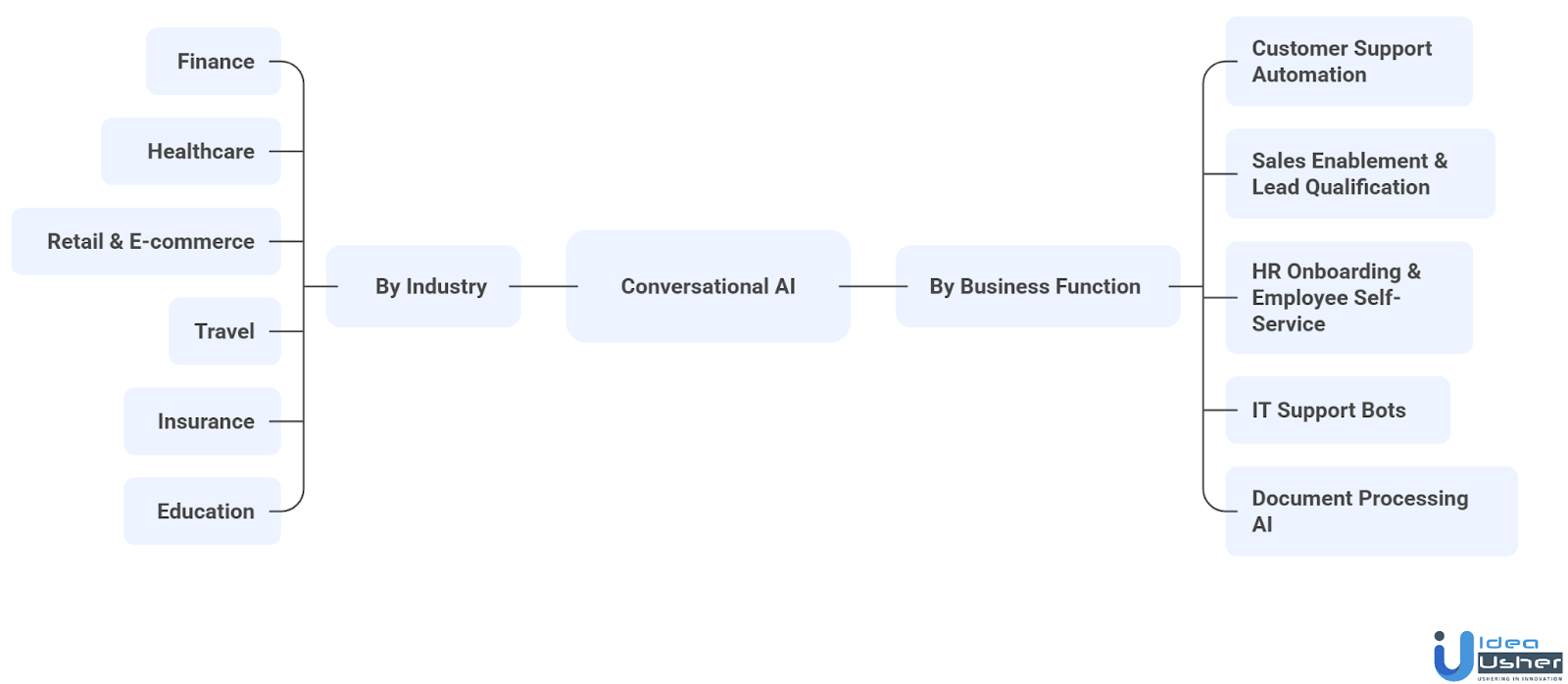
A. By Industry
Conversational AI adoption varies by sector, with industries using automation to address unique customer, operational, and compliance challenges. From retail to healthcare, AI offers tailored experiences that improve efficiency and outcomes.
1. Finance: Secure Onboarding & Fraud Checks
Conversational AI speeds up KYC, detects fraud instantly, and ensures compliance, helping financial institutions reduce onboarding time, cut operational risks, and build customer trust with secure, consistent interactions.
Example: Bank of America’s Erica assists over 35 million users with account management, bill reminders, and fraud alerts.
2. Healthcare: Virtual Nurse Assistants & Scheduling
AI assistants handle appointment bookings, symptom checks, and follow-up reminders, reducing administrative load and improving patient engagement. This streamlined automation leads to shorter waiting times and continuous care delivery.
Example: Gyant AI chatbot provides instant triage and connects patients to medical professionals within minutes.
3. Retail & E-commerce: Guided Shopping & Upselling
Conversational AI enables brands to offer personalized product recommendations and real-time purchase support, increasing conversions and boosting average order value. By understanding customer preferences, brands deliver a more humanized shopping experience.
Example: Sephora’s Virtual Artist uses AI to recommend beauty products and create custom looks for each shopper.
4. Travel: Real-Time Support & Booking Automation
AI-powered travel assistants manage bookings, cancellations, and multilingual customer support around the clock. This reduces response time and enhances customer satisfaction, especially during peak travel periods.
Example: KLM’s BlueBot (BB) helps travelers manage bookings, send check-in reminders, and handle FAQs across multiple platforms.
5. Insurance: Claims Automation & Policy Assistance
AI-driven insurance assistants quickly validate claims, handle policy updates, and help users with renewals or refunds. This automation shortens processing time from days to minutes, reduces fraud, and makes the user experience much better.
Example: Lemonade’s “Maya” and “Jim” automate quotes and claims, settling most payouts in under two minutes.
6. Education: AI Tutors & Student Support
Conversational AI offers personalized tutoring, real-time feedback, and interactive learning sessions, enhancing student engagement and retention. Institutions save faculty hours while providing continuous learner support.
Example: Flint’s AI platform for schools covering math, English, computer science, and languages. It offers problem-solving, essay feedback, and role-play dialogs with AI historical figures.

B. By Business Function
Across business operations, conversational AI streamlines processes, reduces manual workloads, and enables faster decision-making. Whether in HR, IT, or customer service, AI tools enhance productivity and boost overall business performance.
1. Customer Support Automation
AI-powered support bots manage FAQs, complaint resolutions, and live chat interactions without human intervention, providing 24/7 customer service while cutting operational costs. Businesses experience faster resolutions and higher customer satisfaction.
Example: Delta Air Lines’ “Ask Delta” chatbot helps customers check in, track baggage, and find flights, and has achieved a 20% reduction in call-center volumes.
2. Sales Enablement & Lead Qualification
Conversational AI finds and connects with potential leads as they come in. It responds to product questions, sets up demos, and sends top prospects to sales reps. This helps speed up the sales process and increase conversions.
Example: Drift’s conversational bots interact with website visitors, qualify leads, and hand them off to human agents seamlessly.
3. HR Onboarding & Employee Self-Service
AI chatbots simplify recruitment, onboarding, and employee query management. They deliver faster candidate screening, streamline internal communication, and ensure consistent HR operations.
Example: Unilever’s HR chatbot automates interview scheduling and onboarding across multiple global markets.
4. IT Support Bots
AI-powered IT bots take care of password resets, fix system issues, and send unresolved requests to the right people. This helps reduce downtime and lets IT teams focus on more complex work.
Example: Now Assist (GenAI by ServiceNow) was added to the IT Service Management ‘Report an Issue’ form, 54% of tickets were resolved through AI self-service, over half handled without human help.
5. Document Processing AI
Conversational AI, combined with OCR and NLP, automates data extraction, validation, and document filing. This leads to faster turnaround times and more accurate results in processes that handle large amounts of data.
Example: UiPath Document Understanding helps enterprises automate invoice validation and compliance documentation.
Core Features of Modern Conversational AI Platforms
Modern conversational AI platforms combine natural language understanding, automation, and analytics to enhance customer engagement and operational efficiency. Below are the core features that define Conversational AI Trends & Use Cases designed for business impact.
1. Natural Language Understanding
NLU helps AI understand what users mean, how they feel, and the situation, not just the words they use. Newer models can remember the flow of longer conversations, which makes interactions feel more natural. This is especially important in customer service, HR, and sales.
2. Multichannel & Omnichannel Support
These platforms integrate seamlessly across chat, voice, email, and social media. Whether a customer interacts via WhatsApp, website chat, or a voice assistant, the experience remains consistent and continuous.
3. No-Code or Low-Code Bot Builder
Modern AI platforms empower non-technical teams to build and deploy bots using intuitive drag-and-drop interfaces. This reduces dependency on developers and accelerates time-to-market for automation projects.
4. Generative AI for Dynamic Responses
Unlike scripted chatbots, generative AI-powered systems create context-aware, adaptive responses. This ensures every conversation feels unique while maintaining brand tone and factual accuracy.
5. Integration with Enterprise Systems
Seamless integration with tools like Salesforce, HubSpot, SAP, or Workday enables the AI to fetch and update data in real time. This transforms bots into powerful digital assistants capable of completing tasks end-to-end.
6. Voice AI & Speech Recognition
Voice-first capabilities support telephony, IVR, and smart assistant experiences. Speech-to-text and natural voice synthesis allow businesses to extend automation beyond text to conversational voice interfaces.
7. AI-Driven Workflow Automation
Conversational AI is no longer limited to just dialogue. It now helps automate backend tasks like scheduling appointments, processing orders, and verifying claims, making operations across departments more efficient.
8. Real-Time Analytics
Built-in dashboards provide visibility into user intent, satisfaction levels, and drop-off points. Businesses leverage these insights to optimize conversations, identify customer needs, and improve overall experience quality.
9. Multilingual & Localization Support
Modern AI platforms support multiple languages and regional dialects to cater to global audiences. Language-specific models ensure culturally accurate and empathetic communication.
10. Security & Compliance
End-to-end encryption, GDPR compliance, and ethical AI frameworks safeguard sensitive data. Role-based access control and model auditability ensure responsible deployment at enterprise scale.
How IdeaUsher Helps Conversational AI Development for Business?
Creating effective conversational AI solutions requires strategy and adaptability. At IdeaUsher, we combine advanced AI technologies with business design thinking to develop intelligent systems that drive growth. Here’s how our end-to-end development approach ensures your business gets a future-ready conversational AI platform:
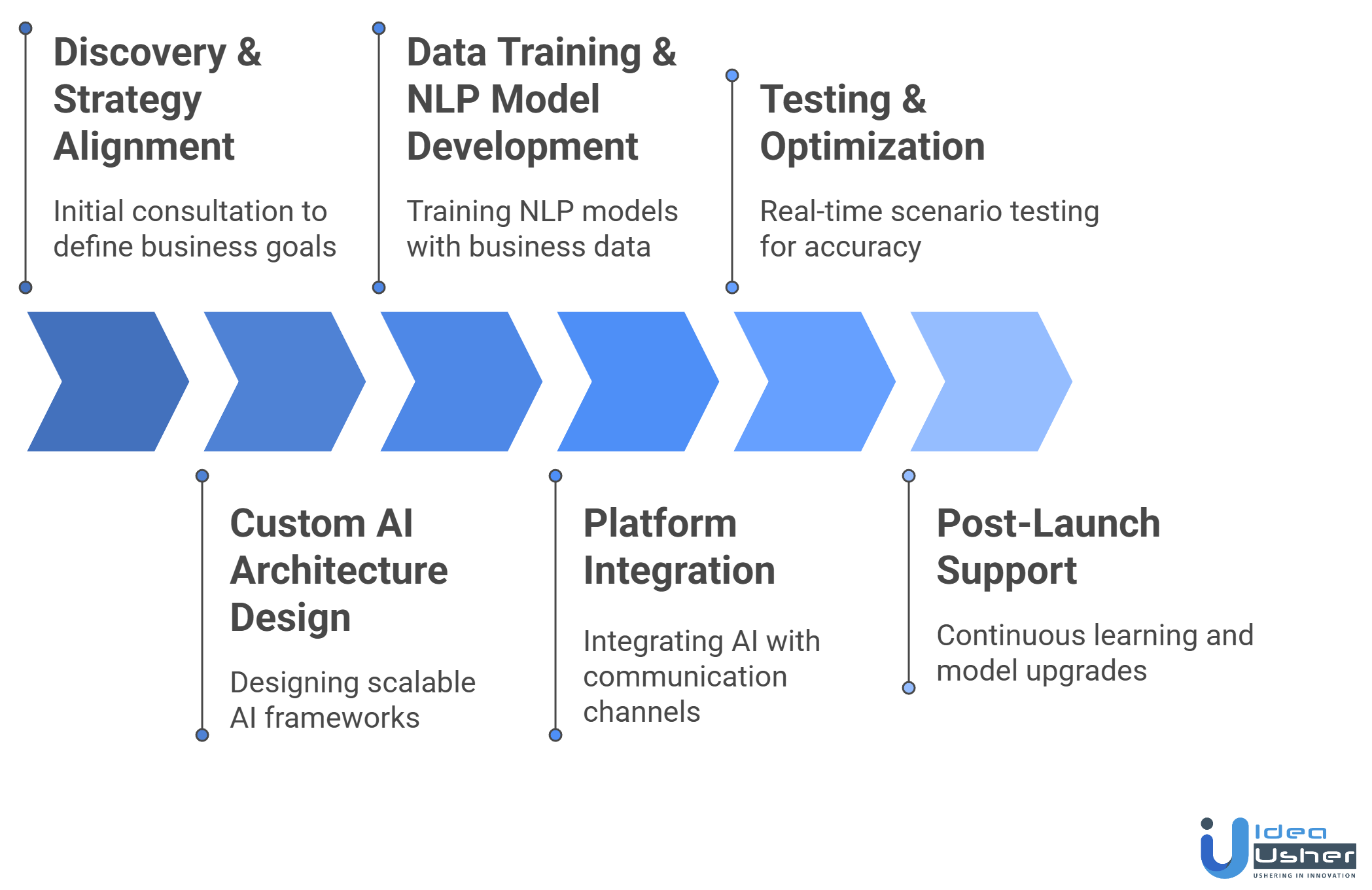
1. Discovery & Strategy Alignment
We begin by talking through your business goals, customer journey, and current communication workflows. This helps us find the right conversational AI model for you, such as a chatbot, voice assistant, or multi-channel agent, that fits your needs and supports your ROI goals.
2. Custom AI Architecture Design
Our AI architects design scalable frameworks leveraging LLMs (like GPT or Gemini), Dialogflow, and Rasa. We define intent structures, conversation flows, and contextual understanding layers to ensure natural, meaningful dialogues tailored to your domain.
3. Data Training & NLP Model Development
We curate and clean training data from your customer interactions, FAQs, and CRM systems to train NLP models that grasp industry-specific language. Using machine learning pipelines, we continuously enhance accuracy and personalization.
4. Platform Integration
We integrate your conversational AI with your preferred communication channels, like WhatsApp, Slack, websites, or mobile apps. We also connect it to your CRM, ERP, and knowledge base systems so you can access all your data in one place and get more relevant responses.
5. Testing & Optimization
Before deployment, we test real-time scenarios to ensure consistent tone, accuracy, and emotional responsiveness. Voice-based systems undergo tone tuning and latency optimization for seamless user experience.
6. Post-Launch Support
After deployment, our AI systems continuously learn from user interactions. We provide analytics dashboards to track intent performance, improve response quality, and roll out model upgrades that keep your AI agent ahead of the curve.
Conclusion
Conversational AI Trends & Use Cases are shaping how businesses communicate, support customers, and scale their services with greater efficiency. From automated responses to intelligent decision support, AI is enabling faster interactions and stronger personalization across industries. As organizations explore new applications, the focus remains on improving experience while reducing operational effort. The real opportunity lies in adopting solutions that adapt to user intent and business goals. Companies that embrace this shift will be better prepared for a future where conversational technology drives lasting customer engagement and growth.
Work with Ex-MAANG developers to build next-gen apps schedule your consultation now
FAQs
Trends include hyper-personalized interactions, voice-enabled solutions, AI-driven analytics, and automation across customer service and internal operations. These advancements help businesses reduce manual efforts, increase satisfaction, and offer smarter, faster support experiences across multiple channels.
Conversational AI offers instant assistance, reduces wait times, and answers routine queries efficiently. It helps support teams focus on complex issues while ensuring customers receive accurate and consistent responses across chat, voice, and messaging platforms at any hour.
Strong returns are seen in customer support automation, lead qualification, feedback collection, and personalized product recommendations. These applications improve conversions, reduce operational costs, and create seamless journeys that encourage repeat engagement and long-term customer loyalty.
Yes, by automating employee FAQs, simplifying IT support requests, and helping departments access information faster. It enhances productivity by reducing manual tasks and ensuring employees can focus on strategic work that supports growth.
